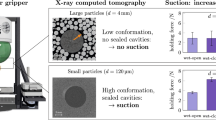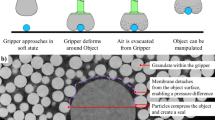Abstract
A granular gripper is a device used to hold objects by taking advantage of the phenomenon of Reynold’s dilatancy. A membrane containing a granular sample is allowed to deform around the object to be held and then vacuum is used to jam the granular material inside the membrane. This allows to hold the object against external forces since deformation of the granular material is prevented by not allowing the system to increase its volume. The maximum holding force supported by the gripper depends on a number of variables. In this work, we show that in the regime of frictional holding (where the gripper does not interlock with the object), the maximum holding force as a function of the penetration of the object in the gripper does not depend on the granular material used to fill the membrane. Results for a variety of granular materials can be collapsed into a single curve if maximum holding force is plotted against the penetration depth achieved. The results suggest that a robotic arm capable of sensing the penetration depth can use this master curve to estimate the maximum holding force at each gripping operation.
Graphical Abstract







Similar content being viewed by others
References
Shintake, J., Cacucciolo, V., Floreano, D., Shea, H.: Soft robotic grippers. Adv. Mater. 1707035 (2018)
Schmidt, I.: Flexible molding jaws for grippers. Ind. Robot. 5, 24 (1978)
Perovskii, A.P.: Universal grippers for industrial robots. Russ. Eng. J. 60, 3 (1980)
Rienmüller, T., Weissmantel, H.: A shape adaptive gripper finger for robots. In: Burckhardt, C.W. (ed.) Proceedings of the 18th International Symposium on Industrial Robots, pp 241-250. IFS Publications, Springer Verlag, Berlin (1988)
Amend, J., Cheng, N., Fakhouri, S., Culley, B.: Soft robotics commercialization: jamming grippers from research to product. Soft Robot. 3, 213 (2016)
Jaeger, H.M.: Celebrating soft matter’s 10th anniversary: toward jamming by design. Soft Matter. 11, 12 (2014)
Brown, E., Rodenberga, N., Amend, J., Mozeika, A., Steltz, E., Zakin, M.R., Lipson, H., Jaeger, H.M.: Universal robotic gripper based on the jamming of granular material. Proc. Natl. Acad. Sci. 107, 18809 (2010)
Reynolds, O.: Experiments showing dilatancy, a property of granular material, possibly connected with gravitation. Proc. R. Inst. BG 2, 354 (1886)
Sakaie, K., Fenistein, D., Carroll, T.J., van Hecke, M., Umbanhowar, P.: MR imaging of Reynolds dilatancy in the bulk of smooth granular flows. Europhys. Lett. 84, 38001 (2008)
Reynolds, O.: On the dilatancy of media composed of rigid particles in contact With experimental illustrations. Lond. Edinb. Dublin Philos. Mag. J. Sci. 20, 469 (1885)
Amend, J.R., Brown, E., Rodenberg, N., Jaeger, H.M., Lipson, H.: A positive pressure universal gripper based on the jamming of granular material. IEEE Trans. Robot. 28, 341 (2012)
Nishida, T., Shigehisa, D., Kawashima, N., Tadakuma, K.: Development of universal jamming gripper with a force feedback mechanism. Joint 7th International Conference on Soft Computing and Intelligent Systems (SCIS) and 15th International Symposium on Advanced Intelligent Systems (ISIS), pp. 242. IEEE, Kitakyushu, Japan (2014)
Meuleman, S., Balt, V., Jarray, A., Magnanimo, V.: Investigation of particle properties on the holding force in a granular gripper. In: Wriggers, P., Bischoff, M., Oñate, E., Owen, D.R.J., Zohdi, T. (eds.) V International Conference on Particle-Based Methods—Fundamentals and Applications, pp. 508 (2017)
Mo, A., Zhang, W.: A novel universal gripper based on meshed pin array. Int. J. Adv. Robot. Sys. 16, 1 (2019)
Acknowledgements
We thank N. Arce and J. P. Cagnola from Universidad Tecnológica Nacional (La Plata) for their contribution in the design and test of the experimental apparatus. We are indebted to G. Corral and M. Baccin for their help during the experiments. This work has been supported in part by ANPCyT (Argentina) through grant PICT-2016-2658, UTN (Argentina) through grant PID-MAUTNLP-4415 and FCEyN-UNLPam through grant F-55.
Author information
Authors and Affiliations
Contributions
JMGP and AAS have contributed equally to this work.
Corresponding author
Ethics declarations
Conflict of interest
The authors declare that they have no conflict of interest.
Additional information
Publisher's Note
Springer Nature remains neutral with regard to jurisdictional claims in published maps and institutional affiliations.
Rights and permissions
About this article
Cite this article
Gómez–Paccapelo, J.M., Santarossa, A.A., Bustos, H.D. et al. Effect of the granular material on the maximum holding force of a granular gripper. Granular Matter 23, 4 (2021). https://doi.org/10.1007/s10035-020-01069-z
Received:
Accepted:
Published:
DOI: https://doi.org/10.1007/s10035-020-01069-z




